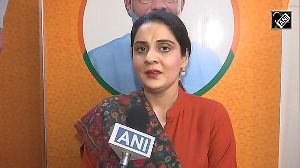That Zee Telefilms is generating investor interest is evident from its stock price movement - the stock has gained 70 per cent in the past year, while the BSE Sensex is up 52 per cent.
An uptrend in programme ratings, value unlocking from the impending demerger, expected boom in the direct-to-home business and the imminent implementation of conditional access system are all acting favourable for the stock considering the fact that it will help the company boost subscription revenues.
"Zee is definitely a stock to own," opines Sumeet Rohra, an analyst at Antique Stock Broking. "The stock will see a further upside of 40-50 per cent in the next two-three months," he adds.
The Delhi High Court has ordered the government to issue a revised notification to implement CAS by December 31 in the notified areas of three metros - Delhi, Mumbai and Kolkata.
This, in a way, paves the path for implementing CAS in other areas. CAS will bring in greater transparency and accountability at all levels besides boosting revenues of broadcasters.
"CAS will ensure that all the stakeholders - consumers, multi-service operators (MSOs), government and the broadcasters - will benefit. Consumers will get a better product offering of their choice at a reasonable rate, which does not exist currently in the non-CAS segment. Broadcasters will enjoy 100 per cent collection and the government will improve tax collection," says Ashish Kaul, senior vice-president, Zee Network.
Analysts say, some interest in the stock can be attributed to the recent Telecom Regulatory Authority of India announcement that mandates the revenue sharing for broadcasters, MSOs and local cable operators (LCOs) from January 1, 2007.
According to this announcement, post-CAS, the share of revenues from pay channels for broadcasters will be 45 per cent, MSOs will earn 30 per cent and LCOs will get 25 per cent, if the service providers fail to agree on mutually acceptable interconnection agreements.
What this means is that Zee's (broadcaster) share in revenues from pay channels will increase to 45 per cent against 15 per cent that it currently receives. And Siticable's (MSO) share will go up to 30 per cent from the current share of 5-10 per cent that it earns.
This translates into higher subscription revenue flows to Zee and Siticable - India's largest MSO. At present, the MSO has 67 lakh subscribers of which only 8 lakh are declared.
Being an integrated player is an advantage for Zee. "The market today is highly unregulated. Once the regulations are in place, it is going to be a great positive for media companies and by virtue of being the largest player, Zee is going to be the greatest beneficiary," adds Rohra.
The company's top line will definitely swell considering the fact that in the June quarter, over 46 per cent of its revenue came from subscription. But the exact impact of this on the company's financials cannot be gauged.
"There would be significant addition to the top line and bottom line. However, at this time, we will not be able to share any numbers," says Kaul.
However, there is one point of contention - that TRAI has fixed a cap of Rs 5 per channel. Some analysts argue that this cap will bring down the revenues for the company apart from leaving little flexibility for fair pricing to channels.
"One thing we need to understand is that the Rs 5 cap is only for CAS areas and not for cable connected homes," says Kaul. Yet, he is of the opinion that market forces must determine the pricing.
"But the other perspective is also that whatever areas are converted into CAS are areas of 100 per cent collection and declaration for both, broadcasters and cable operators. In the long run, the industry is taking a first step towards 100 per cent declaration and having a complete organised and transparent business set-up," he adds.
Analysts are expecting a lot of growth from the DTH business too. The company currently has a subscriber base of 13 lakh and it adds 5,000 boxes a day, and has recently enhanced its offerings. It has set a target of 23 lakh subscribers by the end of FY07.
DishTV, the company's DTH business, recently made available the OneAlliance bouquet to its subscribers, and will soon bring the STAR bouquet. Both these bouquets were not aired earlier.
The enhancement in content with the availability of these channels now is a big positive for the business. Zee expects the DTH business to grow from Rs 80 crore (Rs 800 million) in FY06 to Rs 3,520 crore (Rs 35.20 billion) in 2011 with a subscriber base of 80 lakh. It is expected to reach cash breakeven by FY08.
Also, TRAI has decided that it will not regulate tariffs of DTH operators like it did for channels under CAS.
Even though the cable and DTH businesses will be eyeing the same pie for growth, analysts are pretty confident that both DTH and CAS can co-exist just because of the untapped potential. Of the 11.2 crore (112 million) television homes in India, only around 6.4 crore (64 million) have cable. Thus, there is still immense scope for conversion.
According to the company, Zee TV too has gained the lead position in three prime slots and Zee TV and Zee Cinema are the second and third ranking channels across all genres at present.
The company expects its content business to grow from the current Rs 1,050 crore (Rs 10.50 billion) to Rs 3,960 crore (Rs 39.60 billion) by 2011 - an annualised growth rate of 30 per cent.
The company estimates total advertising on television across all channels to grow at an annualised rate of 14 per cent in this period. Zee's operating profit margin was 23 per cent in FY06, which is expected to improve to 35 per cent in five years.
Earlier in the year, Zee had announced its plans to restructure its business in order to bring in greater clarity and focus to its business. The company will separate its businesses into four entities - Zee Telefilms, Zee News, Wire and Wireless India and ASC Enterprises which would be separately listed on the exchanges.
The process is likely to be completed this month. Analysts say the demerger will unlock value for shareholders. The move will enable the company to bring in strategic investors, more so, in the distribution entity, which will increase the value of the business.
At the current price of Rs 298, the stock trades at 56 times its FY06 earnings. The stock trades at 42 times and 31 times its expected earnings of FY07 and FY08.







 © 2025
© 2025